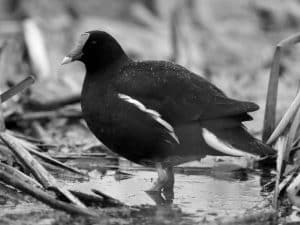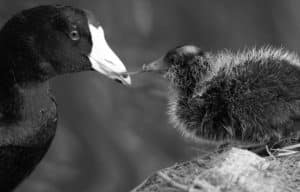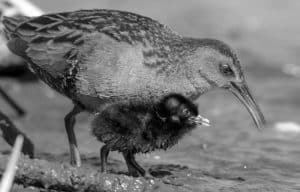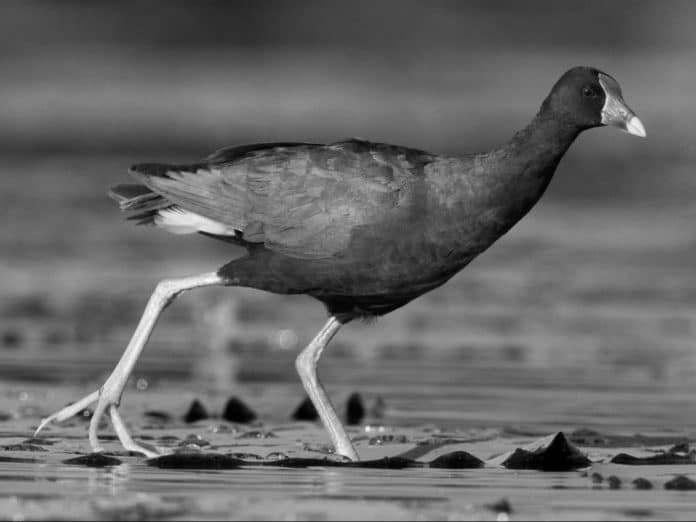Introduction to Tanzania’s Wetland Wonderland
Tanzania boasts an incredible variety of landscapes, from the iconic Serengeti plains to the majestic Mount Kilimanjaro. However, hidden within its borders are some of the most remarkable wetland ecosystems in the world. These wetlands are teeming with life and provide a critical habitat for a multitude of bird species, including the elusive rails, gallinules, and coots in Tanzania.
The Fascinating World of Rails, Gallinules, and Coots

Rails, gallinules, and coots are a diverse group of birds that share a common love for wetlands. Rails, with their slender bodies and long toes, are expert skulkers and can often be heard but not easily seen. Gallinules, also known as moorhens, have vibrant plumage and are known for their distinctive red beaks. Coots, on the other hand, are more commonly seen in open water, with their dark bodies and white bills.
These birds have adapted to life in wetlands, with their long legs and toes enabling them to navigate through marshy areas. They feed on a variety of plant material, insects, and small aquatic creatures, and can often be seen foraging in the shallow waters of Tanzania’s wetlands.
Where to Find Rails, Gallinules, and Coots in Tanzania
Tanzania is home to several prominent wetland areas where one can observe rails, gallinules, and coots in their natural habitat. The Rufiji Delta, located in the Selous Game Reserve, is a prime location for spotting these wetland birds. The delta is formed by the convergence of the Rufiji River and the Indian Ocean, creating a fertile breeding ground for many bird species.
Lake Manyara National Park is another excellent destination for rail, gallinule, and coot sightings. The park’s alkaline lake and surrounding marshes attract a wide variety of waterbirds, including these fascinating wetland species. The nearby Tarangire National Park also offers opportunities to spot rails, gallinules, and coots along the Tarangire River.
Unique Characteristics and Behaviors of Rails, Gallinules, and Coots
Rails, gallinules, and coots exhibit a range of unique characteristics and behaviors that make them captivating subjects for birdwatchers. Rails are known for their cryptic plumage and secretive nature. They use their long toes and slender bodies to navigate through dense vegetation, making them difficult to spot. However, their distinctive calls can often give away their presence.
Gallinules, with their vibrant plumage and red beaks, are more easily seen. They are excellent swimmers and can often be observed gliding gracefully across the water. Coots, on the other hand, are known for their diving abilities. They can stay submerged for extended periods, using their lobed toes to propel themselves underwater in search of food.
Conservation Efforts for Rails, Gallinules, and Coots in Tanzania

The wetland habitats that rails, gallinules, and coots rely on are under constant threat from human activities. Habitat destruction, pollution, and climate change pose significant challenges to the survival of these wetland birds. Fortunately, there are ongoing conservation efforts in Tanzania to protect their habitats and raise awareness about their importance.
Local organizations, such as the Tanzania Bird Atlas Project, work to monitor bird populations and gather valuable data on their distribution and abundance. Wetland reserves and national parks are also implementing measures to safeguard these delicate ecosystems. By supporting these conservation initiatives and practicing responsible tourism, we can help ensure a bright future for rails, gallinules, and coots in Tanzania.
Tips for Birdwatching and Photographing Rails, Gallinules, and Coots
If you’re planning a birdwatching trip to Tanzania’s wetlands, here are some tips to enhance your experience:
- Be patient: Rails, gallinules, and coots can be elusive, so take your time and allow yourself to blend into the surroundings. The more patient you are, the more likely you’ll have a rewarding sighting.
- Use binoculars: A good pair of binoculars is essential for birdwatching. They allow you to observe these birds up close without disturbing them.
- Learn their calls: Familiarize yourself with the distinctive calls of rails, gallinules, and coots. This will help you locate them even when they are hidden from view.
- Respect their habitat: When observing these birds, maintain a safe distance and avoid disturbing their natural behavior. Ensure that you follow any guidelines provided by park authorities or local guides.
Other Bird Species to Look Out for in Tanzania’s Wetlands
While rails, gallinules, and coots are undoubtedly fascinating, Tanzania’s wetlands are also home to a wide array of other bird species. Flamingos, pelicans, herons, and storks are just a few of the stunning waterbirds that can be spotted in these wetland habitats. Keep an eye out for the African fish eagle, known for its majestic flight and haunting call, as well as the vibrant malachite kingfisher.
Best Time to Visit Tanzania for Rail, Gallinule, and Coot Sightings
The best time to visit Tanzania for rail, gallinule, and coot sightings is during the dry season, which typically runs from June to October. During this time, water levels in the wetlands are lower, making it easier to spot these birds as they concentrate around remaining water sources. The months of September and October are particularly rewarding, as resident birds are joined by migratory species.
Recommended Tour Operators and Guides for Wetland Birdwatching in Tanzania
To make the most of your birdwatching experience in Tanzania, consider engaging the services of experienced tour operators and guides specializing in wetland birdwatching. These experts have an intimate knowledge of the best locations, optimal viewing times, and can help you identify and appreciate the diverse bird species you encounter.
Conclusion: Exploring the Beauty of Tanzania’s Wetlands and its Feathered Inhabitants

Tanzania’s wetland wonderland is a paradise for bird enthusiasts, offering a chance to explore the remarkable world of rails, gallinules, and coots. From their elusive nature to their captivating behaviors, these wetland birds never fail to leave a lasting impression. By supporting conservation efforts and practicing responsible tourism, we can help preserve the wetland habitats that are vital for the survival of these remarkable species. So grab your binoculars and camera, and embark on an unforgettable journey to Tanzania’s wetlands to witness the magic of rails, gallinules, and coots in their natural habitat.


































